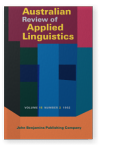Migrant engineers’ job interview performance
A cross cultural analysis
More than 12,000 migrant engineers have migrated to Australia in the past four years – the majority NESB professionals of prime workforce age selected under the skilled immigration program.
These engineers are currently experiencing extreme levels of unemployment – in part due to Australia’s recession, but in part due to disproportionate labour market rejection.
This paper examines the critical ‘gatekeeping’ role of the employment interview. It explores the cultural attitudes a range of East European engineers bring to Australian engineering job interview questions – in particular ‘process’ questions (requiring detailed description of knowledge of engineering processes), and ‘self-promotion’ questions (inviting positive presentation of demonstrated professional skills).
The paper then analyses the videotaped job interview performance of two East European engineers, who answer such questions poorly in interviews conducted by the Institution of Engineers, Australia. The paper suggests that disparities between country of origin interview strategies and those used in Australia might usefully be targeted as areas for further research. Such research could lead to more effective cross-cultural interview training, while lessening the risk of interview failure.
References (20)
APES A (Association of Professional Engineers and Scientists, Australia)
(
1991) Unpublished letter to L. Hawthorne, in support of her research submission to the Bureau of Immigration Research on Labour Market Participation of Migrant Engineers: Barriers to Employment.

Bennett, A.
(
1982)
Strategies and counterslrategies in the use of yes/no questions in discourse. In
J. Gumperz (ed.)
Language and social identity. Cambridge, Cambridge University Press.

CAAIP (Committee to Advise on Australia’s Immigration Policies)
(
1988)
Immigration, a commitment to Australia. Canberra, Australian Government Publishing Service.

Clyne, M.
(
1985)
Beyond grammar: Some thoughts on communication rules in our multicultural society. In
J. B. Pride (ed.)
Cross-cultural encounters: Communication and mis-communication. Melbourne, River Seine Publications.

Dodd, C. H.
(
1987)
Dynamics of inter cultural communication.
Iowa, W. C. Brown.

Gumperz, J. and J. Cook-Gumperz
(
1982)
Introduction: language and the communication of social identity. In
J. Gumperz (ed.)
Language and social identity. Cambridge, Cambridge University Press.


Gumperz, J.
(
1982)
Discourse strategies. Cambridge, Cambridge University Press.


Gumperz, J. and D. Hymes
(eds) (
1972)
Directions in sociolinguistics. New York, Holt, Rinehart & Winston.

Hawthorne, L.
(
1992)
Unpublished analysis of migrant engineer arrivals, by ethnicity and field, 1987 to 1991 inclusive. Raw data provided by the Department of Immigration, Local Government & Ethnic Affairs. Canberra.

Hawthorne, L.
(
1993 forthcoming)
Labour market participation of migrant engineers: Barriers to employment. Melbourne, Bureau of Immigration Research.

Hussey, B. and L. Hawthorne
(
1989)
English for occupational purposes: The Regent materials. Melbourne, Royal Melbourne Institute of Technology.

Institution of Engineers, NSW
(
1992, unpublished)
Survey of engineering employers’ attitudes to migrant engineers’ employment.

Keys, Sir W.
(
1990)
Overseas skills recognition: The impact on business opportunities.
In Developing your workforce for the future. Sydney, International Business Communications.

Jupp, T., C. Roberts and J. Cook-Gumperz
(
1982)
Language and disadvantage: The hidden process. In
J. Gumperz (ed.)
Language and social identity. Cambridge, Cambridge University Press.

Lalljee, M.
(
1987)
Attribution theory and intercultural communication. In
K. Knapp,
W. Enninger and
A. Knapp (eds)
Analysing intercultural communication. The Hague: Mouton.


Mishra, A.
(
1982)
Discovering connections. In
J. Gumperz (ed.)
Language and social identity. Cambridge, Cambridge University Press.

Niyi Akinnaso, F. and C. Seabrook Ajirotutu
(
1982)
Performance and ethnic style in job interviews. In
J. Gumperz (ed.)
Language and social identity. Cambridge, Cambridge University Press.

Office of Multicultural Affairs
(
1989)
Towards a national agenda for a multicultural Australia. Canberra, Australian Government Publishing Service.

Roberts, C. and P. Sayers
(
1982)
Keeping the gate: How judgements are made in interethnic interviews. In
K. Knapp,
W. Enninger and
A. Knapp (eds)
Analysing intercultural communication. The Hague: Mouton.

Williams, T.
(
1985)
The nature of mis-communication in the cross-cultural employment interview. In
J. B. Pride (ed.)
Cross-cultural encounters: Communication and mis-communication. Melbourne, River Seine Publications.

Cited by (2)
Cited by 2 other publications
Reissner-Roubicek, Sophie
Reissner-Roubicek, Sophie
This list is based on CrossRef data as of 29 june 2024. Please note that it may not be complete. Sources presented here have been supplied by the respective publishers.
Any errors therein should be reported to them.
